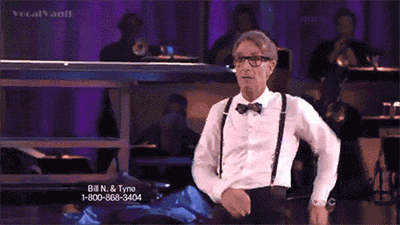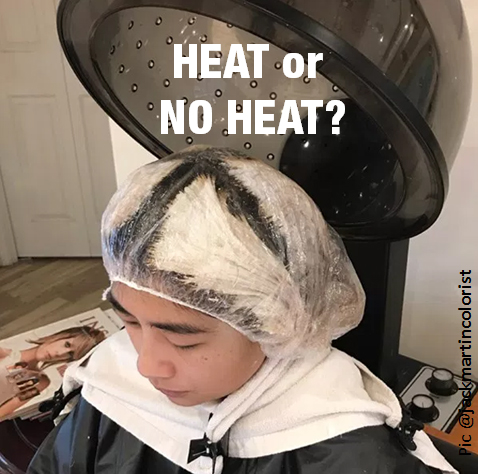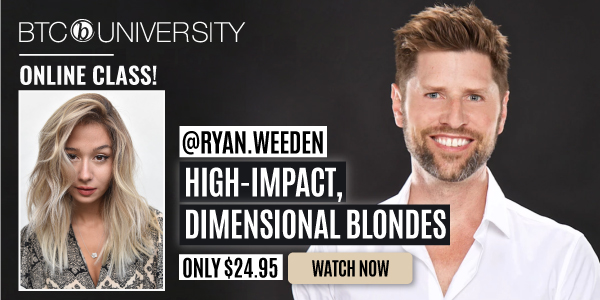What Would You Do: Processing Lightener With Heat
A Level 4 wants to go blonde—do you sit her under the dryer with a head of lightener? What about popping a processing cap on a platinum retouch Working with bleach can be painful—and it hurts even more when the client calls back to say she has sores all over her head. You all weighed in on how to handle THAT situation (read all about it here!), but it opened up another point of discussion…when (if ever) should you use heat—from a dryer, infrared heat, or a processing cap—to speed up lightener? Check out all the responses below!
Got a question? DM us on Facebook or Instagram!

Let The Science Work—WITHOUT Heat
“An educator once told me that rules are rules. You can either abide by them, bend them, or break them. Most lighteners say no heat. Some lighteners say heat is okay but that the lightener shouldn’t be used for all-over lightening. Either way, no heat means NO HEAT. A processing cap creates body heat. That’s sort of bending the rule. Can you get away with it? Sure. A dryer is BREAKING the rule. And you might get away with it once, but probably not more than once on the same head of hair. I’m going to trust the genius minds who developed these products and follow their rules. NO HEAT.” – Taylor Woody Ledford
“If I feel I can’t get someone to their desired level without heat, I will explain during consultation and rebook them to come back in a few weeks for treatments and to lighten again.” – Megan Hall
“I do not use heat. If you understand your client’s hair type, timing and developer, there shouldn’t be a reason to apply heat. You’re only unnecessarily damaging or compromising the integrity of your client’s hair.” – Sarah Stewart
“No matter what products you use, the main factor and component with developer is time. Yes, everyone knows that heat makes things move faster, but the right products and the right developer will do that without the potential sacrifice of the integrity of the hair. Developer volume is based on peroxide levels, level equals time. Yes, heads differ in level, condition, texture, density, medications, etc. But I have very little doubt that if you talk to the top colorists on the planet, they will tell you no heat, and know your developer. Know how it works, use it the way it is meant to be used and you get the results you need, without needing heat to speed it up. It takes the time it takes. It is a fact that the science will bear out every time.” – Kim Stair
Use Heat Sometimes…But Be Careful
“Yet another reason why the consultation is key. If you feel like you have to use heat with your lightener to achieve a certain result, it’s best to express that to your client and make sure they understand the risks (i.e. the possibility of sores, burns, scabs, etc.) and then make them sign a waiver which states that you’ve explained the risks and that the client understands said risks.” – Rae Chole Rivera
“Depends on the client, the hair, the product…There are lots of factors that go into making the best decision for your client’s hair. I worked in a cold salon that the owner never turned the heat on in, so my clients sometimes wouldn’t even process unless I used a LITTLE heat. You can’t just say no and write it off. There isn’t only one correct way to do hair.” – Mandy Maurer
“I sometimes use a little heat…90 degrees (cooler than the body’s 98.6-degree natural temp) with low developer in a dryer hood set way up high off the clients head. I am not frying them, just creating enough heat to keep the bleach going.” – Erin Pierce
“It depends. Obviously not for a scalp bleach, but for balayage or ombré if the hair is dark and stubborn and the desired look is quite cool/ashy, then yes.” – Sasha la Bagasha
“I always taught this—Climazon or cap, never together. Heat and a cap together?…phew, it’s hot in there!” – Rachel Goodyer
“So recently the salon didn’t have much heat and it was colder in the salon. The lightener wasn’t processing to its full potential. In that case, we used heat. Otherwise, unless it’s stubborn hair, I just moisten the inside of a processing cap to make sure the lightener doesn’t dry out and the natural heat from the client’s scalp will give the result you want.” – @neo.tress.visage
“If I am trying to break past orange on the midshaft of a client whose hair was previously colored very dark, Level 4 or darker, I will sometimes apply heat for 10 minutes or so. These clients know that they are running a high chance of damage to their hair and are willing to take that risk. Otherwise, I think heat tends to cause brassier results for me, so I don’t use it. And I never use it with bleach on scalp.” – @stylistjacqui
So What Do You Do To Prevent Burns Or Sores?
“Follow the manufacturer’s instructions. That way, if a customer does become chemically burned, you are not liable because you followed the manufacturer’s instructions.” – Michelle Graham
“Add b3 Brazilian Bond Builder to the formula and make sure your clients are not coming with dry scalp, open sores or scratched scalps. Apply a layer of oil or cream to the scalp only before application.” – Jessica Robinson-Kimes
“I bleach my hair every other month and it’s a harsh chemical—you’re going to have pain, blisters and weeping. It’s awful, but it goes away. Before I do my bleach-outs, especially if they’ve never had it done before, I always go over my ‘terms and conditions’—bleach-outs SUCK. Everyone gets it and no one complains (knock on wood). If you get someone questionable, have them sign a waiver that doesn’t leave you liable…But don’t use heat (at all with bleach) or over 30-volume on scalp. That’s asking for trouble.” – Jeannie Seiler-Laderer









